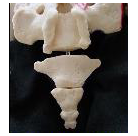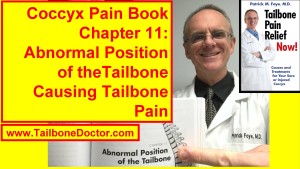Tailbone Book, Chapter 11: Abnormal Coccyx Position Causing Coccyx Pain, Tailbone Pain
- Is your Coccyx Pain Caused by an Abnormal Position of Your Coccyx???
- This is the next in a series of coccyx pain videos, giving you highlights from the chapters of Dr. Foye’s book, “Tailbone Pain Relief Now!”
The actual VIDEO is at the bottom of this page.
Here is the TEXT from the video:
- Tailbone pain can sometimes be caused by an abnormal position of the tailbone or coccyx.
- I’m Dr. Patrick Foye. I’m an M.D. or Medical Doctor.
- And I’m the Director of the Coccyx Pain Center or Tailbone Pain Center here in the United States.
- I’m online at www.TailboneDoctor.com.
- This is the next in a series of videos where I’m going chapter by chapter through my book “Tailbone Pain Relief Now!” providing the highlights of each of the chapters along the way.
- And for this one we are at Chapter 11, which is “Abnormal Position of the Tailbone” or coccyx, as a cause of tailbone pain, coccyx pain or coccydynia.
- And the general idea here is that there’s variability from person to person in terms of the shape and size and position of the tailbone.
- And sometimes that can be something that causes tailbone pain, particularly when somebody is sitting down and putting their body weight onto the tailbone.
- So in this video we’re just going to talk very briefly about a couple of the highlights from Chapter 11 of the book and specifically we are going to touch on two topics… Number one: what if the tailbone is too far forward? And number two: what if it is too far backwards?
- So if the tailbone is flexed too far forwards, I am going to grab a model here and show you what may happen.
- So here we have the lumbar spine up here and then down here is the sacrum and down here is the coccyx or tailbone.
- And sometimes the tailbone can swing too far forward and if it does if it’s flexed too far forward, where my finger is now, for example, it has the potential to cause certain problems.
- Number one, the tailbone is too far pushed into the pelvis and what that means is that if the tailbone is here, then when you have a bowel movement, the stool collects in the rectum which is right in this area.
- So some people will have tailbone pain because the coccyx or tailbone is flexed too far forward, it’s actually blocking or obstructing the area where stool collects in the rectum to have a bowel movement.
- And those people, as the stool collects, will start to have soreness and pain and aching.
- And also, while you’re having a bowel movement it may be painful because the stool is pushing down through the rectum and is pushing that tailbone out of the way.
- So that’s a tailbone that is flexed too far forwards.
- Sometimes you can actually see that on the M.R.I. studies, there’s a particular view that needs to be done that’s unfortunately usually not done with a standard or typical pelvic MRI.
- But if it’s specifically requested, there is a view that can be done that will show this nicely.
- And it can show if the tailbone is sort of indenting into the rectum, that lowest part of the colon or the lowest part of the large intestine.
- So that’s if a tailbone is flexed too far forward.
- What if a tailbone is extended too far backwards?
- This particular model does not let me really crank on it to show that, because I don’t want to break the model.
- But if the tailbone instead of curving too far forward or being in its kind of normal slightly forward position, if the tailbone was instead extended backwards, well that causes a different set of problems.
- Number one is that when you sit, the tailbone is sticking out.
- And by sticking out… then when you go to sit… if this is the chair that you’re sitting on, that tailbone that is… (I can actually swing this model around I guess and show you… here would be if the tailbone was extending backwards).
- Now instead of the tailbone being out of the way when you go to sit down on the chair, the tailbone now is basically contacting the chair.
- And instead of the normal sort of rocker bottom aspect of the coccyx where it’s like the bottom of a rocking chair, instead if that lowest segment is tilting back, you can see that that is not going to be able to perform that rocking motion smoothly.
- And instead it’s going to be pinching against the chair that you’re sitting on. So that’s going to pinch the skin in that area.
- It can cause pain and inflammation there and it can also transmit those forces or pressures upstream. Just like if you ever caught a baseball or football or basketball and sort of jammed your finger while you’re catching it. You know that by doing that you kind of jam the fingers and then you can get pain within those joints.
- Well similarly here if you’re sitting on a tailbone that’s extended backwards, you can sort of jam the joints there and have pain not just where the tailbone is contacting the chair but also at the joints up along the way.
- So that’s a tailbone that’s extending too far backwards.
- It’s important to have the imaging studies to see what is the position of the tailbone in any given patient who has tailbone pain. And that’s also going to help you to know what type of treatment might be appropriate and what types of problems those patients may run into.
- I should also mention that for the patient who had the tailbone very far forward, that tailbone may be extending into the pelvis in a way that blocks or obstructs the birth canal.
- So if the tailbone is hooked very far forward and it’s in the way of the birth canal that the child passes through or baby passes through during childbirth or labor and delivery then that can cause problems during childbirth both for the mom and potentially even for the baby.
- So again it’s important to know the position of the tailbone in order to know what you should do about it and what the situation would be in those different scenarios.
- This is showing a tailbone that is hooked and heading kind of far forward in that way.
- So anyway, those are just a few highlights from Chapter 11 of the book.
- If you’re looking for a full copy of the book, either the e-book which is the electronic book, or the paperback copy, it’s 272 pages all about the coccyx.
- You can get that on Amazon.
- But the easiest way perhaps is to just go to the website www.TailboneBoook.com and that will have the links directly to the Amazon pages that have this; depending on what country you’re in you click the appropriate link that matches there. That’s one way to find it.
- You can also find me online or if you’re interested in coming for an evaluation here at the Coccyx Pain Center. The easiest way to do any of those things or to find other educational content and videos and articles that I have on tailbone pain is to find me at www.TailboneDoctor.com.
- If you have comments or thoughts or questions about an abnormal position of the tailbone, the topic from this chapter of the book, post your comments down below.
- I will be interested to read those and hopefully respond to those.
- And others I am sure will be interested to read and respond to those as well.
- So I look forward to your comments down below.
- Okay, bye bye.
Here is the actual VIDEO:
Here is the screenshot thumbnail image for the video:
To get your copy of the book “Tailbone Pain Relief Now!” go to: www.TailboneBook.com
For more information on coccyx pain, or to be evaluated at Dr. Foye’s Tailbone Pain Center in the United States, go to: www.TailboneDoctor.com
Latest posts by Patrick Foye, M.D. (see all)
- Coccygectomy: Expected Recovery and Return to Work after surgery for coccyx pain, tailbone pain. - November 28, 2023
- PRP Platelet Rich Plasma or Prolotherapy for Tailbone Pain, Coccyx Pain - October 25, 2023
- Reasons for Normal X-rays and MRI Despite Tailbone Pain, Coccyx Pain - October 3, 2023


